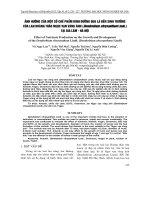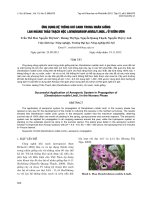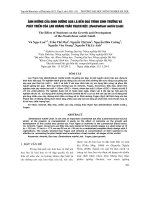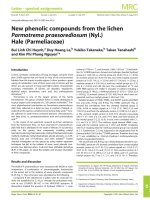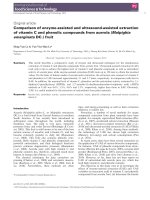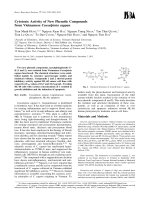Phenolic compounds from Dendrobium nobile Lindl.
Bạn đang xem bản rút gọn của tài liệu. Xem và tải ngay bản đầy đủ của tài liệu tại đây (477.38 KB, 8 trang )
JST: Engineering and Technology for Sustainable Development
Volume 32, Issue 3, July 2022, 034-041
Phenolic Compounds from Dendrobium Nobile Lindl.
Nguyen Thi Viet Thanh1*, Pham Hai Yen2
1
School of Chemical Engineering, Hanoi University of Science and Technology, Hanoi, Vietnam
Institute of Marine Biochemistry, Vietnam Academy of Science and Technology, Hanoi, Vietnam
*
Email:
2
Abstract
Dendrobium nobile Lindl.(Orchidaceae), Vietnamese name as Hoang thao dui ga is an epiphytic plant on high
tree branches. It grows widely in humid mountainous areas in Vietnam. The plant is used to treat fever, dry
mouth, dry throat, increase vitality in traditional medicine. In the course of study on chemical composition of
Dendrobium nobile Lindl. in Vietnam, this paper describes the extraction and structure evaluation of five known
compounds, including E-1,5-bis(4-hydroxyphenyl)-pent-1-en-3-one (1) together with ferulic acid (2), 4-hydroxy
cinnamic acid (3) umbellic acid (4) and 3-(4-hydroxyphenyl) propionic acid (5). The stems of this plant were
collected, identified, dried and extracted in different polarity solvents. These substances were isolated from
the ethyl acetate and water fractions of methanol extract on the basis of column chromatography. Their
structures were identified based on spectroscopic evaluation and comparison of corresponding authentic
compounds. This is the first report of compound 1 from the Dendrobium genus.
Keywords: Dendrobium nobile Lindl., phenolic, acid.
1. Introduction *
such as D. officinale. Bioactivity studies also
demonstrated that Dendrobium has comprehensive
biological activities, related to immunity, nervous,
cardiovascular, endocrine, digestive and urinary
systems [1,2,3]. Especially, polysaccharides have
demonstrated multi-purpose uses, such as: boost
immunity, antitumor, antioxidant.
Over the past 80 years, more than 40 species of
the Dendrobium genus have been studied. Previous
reports on the chemical components of the
Dendrobium genus have revealed that this genus was
abundant of aromatic compounds, sesquiterpenoids,
alkaloids and polysaccharides [1]. A large number of
aromatic compounds, represented as bibenzyl,
phenanthrene, fluorenone and coumarin have been
isolated from the genus Dendrobium. Common
bibenzyls were present in many different species of
Dendrobium. For example, moscatilin and gigantol
were isolated from nearly 20 species of Dendrobium.
The naturally occurring phenanthrenes in Dendrobium
species occured as hydroxyl and/or methoxy
substituted 9,10-dihydro or dehydro derivatives. The
number of hydroxyl and methoxy in the molecules also
ranged from 3 to 6 groups. Fluorenone and coumarin
were present in much lower amounts than bibenzyl and
phenanthrene in Dendrobium. Alkaloids were the first
groups extracted and structurally determined from the
genus Dendrobium. Up to now, there are many
different alkaloid skeletons, which are sesquiterpene,
indolizidine, pyrrolidine, phthalide and imidazole
frames found. Sesquiterpenoids are also commonly
found in the genus Dendrobium and are mostly found
in Dendrobium nobile Lindl. (D.nobile) and
D.moniliforme. Picrotoxane was the most common
sesquiterpenoid. In addition, alloaromadendrane,
cyclocopacamphane, cadinene and muurolene, have
also been found in the genus. Polysaccharides always
presented in large amounts in the genus Dendrobium,
D.nobile, Vietnamese name as Hoang thao dui
ga, is an epiphytic species, distributes throughout the
mountainous areas of the northern and central
provinces. The stem is about 0.3-0.6 m high and
slightly flattened. Leaves are 12 cm long, 2-3 cm wide.
The inflorescences grow in clusters of 2-4 flowers on
peduncles 2-3 cm long. Flowers are very beautiful with
oval lip wings, 4-5 cm long, 3 cm wide rolled into a
funnel in the flower, and the flower throat has a purple
point. The plant was used in traditional medicine to
help replenish the body's fluids. D.nobile's alkaloidbased functional foods are used to increase strength for
sport activities. Phytochemical studies reported some
remarkable classes of substances in this plant (Fig. 1).
The basic alkaloids of the plant are dendrobine, salts
of dendrobine, nobilonine, dendramine, and dendrine,
in which dendrobine, nobilonine were the main
alkaloid components of the plant. The sesquiterpenes
includes
copacamphane,
picrotoxane
and
cyclocopacamphane skeretons. Phenathrenes and
bibenzyls were isolated as well. In addition, D.nobile
also contained phenolic acids such as 4hydroxybenzoic acid, vanillic acid, syringic acid,
ferulic acid [1,4,5].
ISSN 2734-9381
/>Received: February 10, 2022; accepted: April 8, 2022
34
JST: Engineering and Technology for Sustainable Development
Volume 32, Issue 3, July 2022, 034-041
OH
H
CH3
H
H HO
H
OH
OH
11
H
8
9
H
10
8
9
7
OH
1
H
2
6
3
5
H
4
15
O
H
4
14
3
15
4
5
H
H
12
H
HO
14
13
HO
6
1
H
5
OH
3
H
H
13
OH
H
10
11
12
OCH3
4
2
15
14
H
OH
D8
D7
R5
8a
8
R1
2
4a
3
O
O
H
H
9
10a
R4
7
4b
5
4
R2
H
H
D6
10
R1
OH
OH
13
D5
1
5
2
12
OH
13
15
3
12
H
O
O
H
H
H
2
7
9
6
1
14
8
7
OH
6
1
H
HO
8
9
10
7
OH
D4
D3
11
10
O
D2
11
O
O
D1
CH3
CH3
O
O
OH
O
NCH3
O
O
N
CH3
O
CH3
CH3
H
NCH3
NCH3
O
R3
R2
6
OCH3
R3
OCH3
D12
D13
D14
D9 R1 = R3 = OH, R2 = R5 = OCH3, R4 = H
D10 R1 = OCH3, R2 = R4 = OH, R3 = R5 = H
D11
R1 = R2 = R3 = OH, R4 = R5 = H
R1 = H, R2 = R3 = OH
R1 = H, R2 = OH, R3 = OCH3
R1 = R3 = OH, R2 = OCH3
Fig. 1. Some compounds were isolated from Dendrobium nobile Lindl.
HO
O
OH
4''
1''
3
1
1'
H3CO
4'
5
1
HO
6
3
7
8
O
O
COOH
9
3
3
HO
1
1
9
HO
1
OH
5
2
O
1'
OH
2
4
7
OH
HO
4'
5
4
Fig. 2. The chemical structures of compounds 1-5
35
3
1
OH
JST: Engineering and Technology for Sustainable Development
Volume 32, Issue 3, July 2022, 034-041
in parts per million (ppm). The abbreviations used to
report the data are s (singlet), d (doublet), t (triplet),
q (quartet), m (multiplet), and br. (broad).
However, in Vietnam, the studies have only
focused on the ecology of the genus Dendrobium such
as the clonal propagation process, the development of
buds and flowers, the fertilization process, etc. [6], [7].
Researches on D.nobile have not concentrated on its
chemical composition. In this paper, 5 phenolic
compounds (Fig. 2) were isolated and characterised of
from this species in Vietnam.
ESI mass spectra were recorded on an AGILENT
1200 series LC-MSD Ion Trap.
Melting point was measured on a Cole-Parmer
Instrument electrothermal melting point apparatus,
serial number R216000334.
2. Materials and Methods
Plant sample was extracted with methanol using
Vevor Ultrasonic model JPS-100A.
2.1. Plant Materials
The stems of Dendrobium nobile Lindl. (Fig. 3)
were collected in Bo Trach mountain, Quang Binh
province in April 2016. The plant samples were then
preserved to create specimens and identified by Dr.
Bui Van Thanh (Institute of Ecology and Biological
Resources - Vietnam Academy of Science and
Technology (VAST). As the result, this plant was
Dendrobium nobile Lindl., belonged to the
Dendrobium genus, the Orchidaceae family. A
voucher specimen (DN1) was deposited at the Institute
of Ecology and Biological Resources, VAST.
2.3. Extraction and Isolation
The cleaned stems of D.nobile was cut in small
pieces, dried and grinned. The dried powders of
D.nobile stems (5.0 kg) were sonicated with methanol
at room temperature (3 times × 10 L, each 1 h). The
extracts were collected, filtered and distilled to recover
the solvent under reduced pressure to obtain 280.0 g of
methanol extract (DN). This residue was suspended in
water and extracted with dichloromethane and ethyl
acetate, respectively. The dichloromethane, ethyl
acetate extracts were distilled to recover the solvent
under reduced pressure to obtain dichloromethane
fraction (DN1, 150.0 g), ethyl acetate fraction (DN2,
32.0 g) and water residue. The DN2 fraction was
objected on silica gel chromatographic column with a
dichloromethane/methanol gradient elution system
(100/0 → 0/100, v/v) to obtain 8 fractions (E1- E8).
The E2 fraction was chromatographed on the RP-C18
silica gel column with acetone/water elution system
(1/1, v/v) as diluted solvent to obtain two sub-fractions
(E2A- E2B). The E2A sub-fraction was continued to
be chromatographed on the RP-C18 silica gel column
with the methanol/water elution system (1/1.5, v/v) to
give the compound 3 (13.0 mg). The E2B sub-fraction
was continued to be objected to silica gel
chromatographic column with the eluent system of nhexane/dichloromethane/methanol (7/10/1, v/v/v)
to obtain compound 1 (8.0 mg). The E4 fraction
was chromatographed on a silica gel chromatographic
column
with
the
elution
system
of
n-hexane/dichloromethane/methanol (5/10/1, v/v/v) to
obtain 2 E4A- E4B fractions. Compound 5 (6.0 mg)
was obtained after purification of fraction E4B by
reversed phase RP-18 chromatography column with
acetone/water elution system (1.5/1, v/v). The aqueous
solution was evaporated to remove ethyl acetate to
yield water residue, which was then objected on a
Diaion HP-20 column, removed sugar with water, then
gradually increased the concentration of methanol in
water (25, 50, 75 and 100% methanol) to obtain 4
fractions, W1 - W4. The W4 fraction was put on a
normal phase silica gel chromatographic column with
dichloromethane/methanol/water elution system
(6/1/0.05, v/v/v) to obtain 3 fractions (W4A- W4C).
Compound 2 (18.0 mg), compound 4 (20.0 mg) was
Fig. 3. Dendrobium nobile Lindl.
2.2. General Experimental Procedures
The extracted residues were analyzed and
separated based on chromatographic methods. isolated
compounds were identified based on modern
analytical methods 1D, 2D-NMR, ESI-MS.
Column chromatography was performed using
silica gel (Kieselgel 60, 70-230 mesh and 230 - 400
mesh, Merck) as stationary phase or RP-18 resins (150
µm, Fuji Silysia Chemical Ltd.) as reversed phase.
Thin layer chromatography (TLC) was
performed using a pre-coated silica-gel 60 F254 (0.25
mm, Merck) and RP-18 F254S plates (0.25 mm, Merck).
NMR spectra were recorded on a Agilent 400 MR
NMR spectrometer (400 MHz for 1H-NMR and 100
MHz for 13C-NMR). Chemical shifts (δ) are reported
36
JST: Engineering and Technology for Sustainable Development
Volume 32, Issue 3, July 2022, 034-041
4-hydroxy cinamic acid (3): Colorless crystal;
mp 213 oC; ESI-MS m/z 165.05 [M+H]+, C9H8O3.
obtained after purification of the W4C fraction by
reverse phase RP-18 chromatography column with
methanol/water elution system (1/1.5, v/v). Column
chromatography performances were monitored by thin
layer chromatography (see Fig. 4). The separated
compounds were structurally determined by 1D, 2DNMR, MS spectroscopy methods.
H-NMR (400 MHz, CD3OD), δ (ppm): 7.59 (1H, d,
J = 16.0 Hz, H-7), 7.45 (1H, d, J = 2.0 Hz, H-2), 7.45
(1H, d, J = 8.4 Hz, H-6), 6.81 (1H, d, J = 8.4 Hz, H-3),
6.81 (1H, d, J = 8.4 Hz, H-5), 6.28 (1H, d, J = 16.0 Hz,
H-8).
1
E-1,5-bis(4-hydroxyphenyl)-pent-1-en-3-one
(1): White amorphous powder; ESI-MS m/z 268.3
[M]+, C17H16O3.
C-NMR (100 MHz, CD3OD), δ (ppm): 171.2 (C-9),
161.1 (C-4), 146.6 (C-7), 131.1 (C-2), 131.1 (C-6),
127.3 (C-1), 116.8 (C-3), 116.8 (C-5), 115.7 (C-8).
13
H-NMR ((400 MHz, CD3OD), δ (ppm): 7.36 (2H, d,
J = 8.4 Hz, H-2', H-6'), 7.29 (1H, d, J = 15.6 Hz, H-1),
6.99 (2H, d, J = 8.4 Hz, H-2'', H-6''), 6.76 (2H, d,
J = 8.4 Hz, H-3', H-5'), 6.66 (2H, d, J = 8.4 Hz, H-3'',
H-5''), 6.37 (1H, d, J = 15.6 Hz, H-2), 3.27 (1H, t,
J = 7.2 Hz, H-4), 2.61 (1H, t, J = 7.4 Hz, H-5).
1
Umbellic acid (4): Colorless crystal; mp 202 oC;
ESI-MS m/z 165.05 [M+H]+, C9H8O3.
1
H-NMR (400 MHz, CD3OD), δ (ppm): 7.87 (1H, d,
J = 16.0 Hz, H-7), 7.31 (1H, d, J = 9.2 Hz, H-6), 6.36
(1H, d, J = 16.0 Hz, H-8), 6.31 (1H, d, J = 9.2 Hz, H5), 6.30 (1H, br s, H-3),
13
C-NMR (100 MHz, CD3OD), δ (ppm): 165.3(C-3),
158.8 (C-4'), 155.6 (C-4''), 138.5 (C-1), 125.9 (C-1'),
129.5 (C-1''), 129.5 (2C, C-2'', C-6''), 129.2 (2C, C-2',
C-6'), 118.8 (C-2), 115.7 (2C, C-3', C-5'), 115.1 (2C,
C-3'', C-5''), 40.7 (C-4), 34.5 (C-5).
C-NMR (100 MHz, CD3OD), δ (ppm): 172.1 (C=O),
162.2 (C-4), 160.0 (C-2), 142.9 (C-7), 131.5 (C-6),
114.9 (C-8), 114.8 (C-1), 108.8 (C-5), 103.5 (C-3).
13
(E)-Ferulic acid (2): Colorless crystal; mp
170 oC; ESI-MS m/z 195.4 [M+H]+, C10H10O4.
3-(4-hydroxyphenyl) propionic acid (5):
Colorless crystal; mp 129 oC; ESI-MS m/z 167.23
[M+H]+, C9H10O3.
1
H-NMR (400 MHz, CD3OD), δ (ppm): 7.16 (1H, d,
J = 2.0 Hz, H-2), 7.04 (1H, dd, J = 2.0, 8.4 Hz, H-6),
6.79 (1H, d, J = 8.4 Hz, H-5), 6.29 (1H, d, J = 16.0 Hz,
H-8), 3.87 (3H, s, 3-OCH3).
H-NMR (400 MHz, CD3OD), δ (ppm): 6.97 (1H, d,
J = 8.0 Hz, H-2', H-6'), 6.63 (1H, d, J = 8.0 Hz, H-3',
H-5'), 2.65 (1H, t, J = 7.6 Hz, H-3), 2.47 (2H, t, J = 7.6
Hz, H-2).
C-NMR (100 MHz, CD3OD), δ (ppm): 171.0 (C-9),
150.5 (C-3), 149.3 (C-4), 146.9 (C-7), 127.8 (C-1),
124.0 (C-6), 116.4 (C-5), 115.9 (C-8), 111.6 (C-2),
56.4 (3-OCH3).
C-NMR (100 MHz, CD3OD), δ (ppm): 177.1 (C-1),
156.7 (C-4'), 133.2 (2C, C-2', C-6'), 133.0 (C-1'),
116.2 (2C, C-3', C-5'), 37.3 (C-2), 31.3 (C-3)
1
13
13
Fig. 4. Diagram of isolation of compounds 1-5 from D. nobile
37
JST: Engineering and Technology for Sustainable Development
Volume 32, Issue 3, July 2022, 034-041
3. Results and Discussion
confirmed clearly on a basis of two-dimensional
spectra HMBC and HSQC. The HSQC showed the
interaction between H-2', H-6' (δH 7.36) and C-2', C-6'
(δC 129.2), H-3', H-5' (δH 6.76) and C-3', C-5' (δC
115.7), the HBMC interaction from H-2' (δH 7.36) to
C-1 (δC 138.5), C-4' (δC 158.8), C-6' (δC 129.2) and
from H-3' (δH 6.76) to C-1' (δC 125.9), C-5' (δC 115.7
Hz) confirmed spectral values at C-1', C-2', C-3', C-4',
C-5' and C-6'. Similarly, the HSQC showed the
interaction between H-2'', H-6'' (δH 6.99) and C-2'',
C-6'' (δC 129.5), H-3'', H-5'' (δH 6.66) and C-3'', C-5''
(δC 115.1), the HMBC correlation from H-2″ (δH 6.99)
to C-1'' (δC 129.5), C-4'' (δC 155.6), C-6'' (δC 129.5) and
from H-3'' (δH 6.66) to C-1'' (δC 129.5), C-2'' (δC
129.5), C-5'' (δC 115.1), C-6'' (δC 129.5) confirmed
spectrum values at C-1'', C-2'', C-3'', C-4'', C-5'' and
C-6''. The correlation from H-1 (δH 7.29) to C-6' (δC
129.2) and from H-2 (δH 6.37) to C-1' (δC 125.9)
confirmed that the double bond at C-1 and C-2 linked
to one aromatic ring. The correlation between H-5
(δH 2.61) and C-4 (δC 40.7), C-1'' (δC 129.5), C-2''
(δC 129.5) approved the linkage of C-5 to the rest
aromatic ring (Fig. 5). All of the NMR data of 1 were
similar to those of E-1,5-bis(4-hydroxyphenyl)-pent1-en-3-one measured in the same solvent (Table 1).
Additionally, the ESI-MS mass spectrometry appeared
an ion peak m/z 268.3 [M]+ corresponding to the
molecular formula of C17H16O3.
The chemical structures of the isolated
compounds were determined based on analysis of
modern spectroscopic methods such as one- and twodimensional nuclear magnetic resonance and mass
spectroscopy.
E-1,5-bis(4-hydroxyphenyl)-pent-1-en-3-one (1)
was yielded from the ethyl acetate extract as the white
amorphous powder. The 1H-NMR spectrum of 1
showed the signals of two aromatic rings with para
substitution at δH 7.36 (2H, d, J = 8.4 Hz), 6.99 (2H, d,
J = 8.4 Hz), 6.76 (2H, d, J = 8.4 Hz) and 6.66 (2H, d,
J = 8.4 Hz). Signals of the olefin protons with trans
configuration were observed at δH 7.29 (1H, d, J = 15.6
Hz) and 6.37 (1H, d, J = 15.6 Hz) and the appearance
of proton signals of two methylene groups at δH 3.27
(2H, t, J = 7.2 Hz) and 2.61 (2H, J = 7.4 Hz). The
13
C-NMR revealed the presence of 17 carbon atoms in
moleculars of 1. The 13C-NMR spectra of 1 showed
signals of 2 aromatic rings with para substitution at δC
158.8 (C, C-4'), 155.6 (C, C-4''), 129.5 (C, C-1'') ),
129.5 (2CH, C-2'' and C-6''), 129.2 (2CH, C-2' and C6'), 125.9 (C, C-1'), 115.7 (2CH, C-3' and C-5') and
115.1 (2CH, C-3'' and C-5''); signals of two extracyclic
olefin carbons at δC 138.5 (CH, C-1) and 118.8 (CH,
C-2), two carbons of methylene signals at δC 40.7
(CH2, C-4) and 34.5 (CH2, C-5). Besides, the
resonance signal of a carbonyl group appeared at δC
165.3 (C-3) (Table 1). Moreover, the structure of 1 was
Table 1: The 1H- and 13C-NMR data for compounds 1 and E-1,5-bis(4-hydroxyphenyl)-pent-1-en-3-one
1
C
HSQC
a,b
δC
δC
#
δHa,c(mult., J, Hz)
1
141.7
138.5
CH
7.29 (d, 15.6)
2
116.6
118.8
CH
6.37 (d, 15.6)
3
169.3
165.3
C
4
42.1
40.7
CH2
3.27 (t, 7.2)
5
35.8
34.5
CH2
2.61 (t, 7.4)
1'
127.6
125.9
C
2', 6'
130.5
129.2
CH
7.36 (d, 8.4)
3', 5'
116.2
115.7
CH
6.76 (d, 8.4)
4'
160.5
158.8
C
1''
131.1
129.5
C
2'', 6''
130.7
129.5
CH
6.99 (d, 8.4)
3'', 5''
116.2
115.1
CH
6.66 (d, 8.4)
4''
156.9
155.6
C
a)
b)
c)
#
Recorded in CD3OD, 100 MHz, 400 MHz, δ C of E-1,5-bis(4-hydroxyphenyl)-pent-1-en-3-one in
CD3OD[8]
HO
4' OH
4''
1''
5
1
1'
O
1
Fig. 5. The key HMBC correlations of compounds 1
38
JST: Engineering and Technology for Sustainable Development
Volume 32, Issue 3, July 2022, 034-041
Hence, the structure of 1 was established as E1,5-bis(4-hydroxyphenyl)-pent-1-en-3-one based on
the spectra interpretation and the comparison of NMR
data with the published spectra in literature [8]. This is
the first report of this compound from genus
Dendrobium.
the signal of an olefin carbon pair occurred at δC 146.6
(CH, C-7) and 115.7 (CH, C-8). In addition, on the
spectrum, there was a resonance signal of a carbonyl
group at δC 171.2 (C, C-9). The HSQC interaction of
H-2 (δH 7.45) and C-2 (δC 131.1), H-3 (δH 6.81) and
C-3 (δC 116.8), H-5 (δH 6.81) and C-5 (δC 116.8), H-6
(δH 7.45) and C-6 (δC 131.1) confirmed signals of
protons and carbons in the aromatic ring. The HSQC
interaction from H-7 (δH 7.59) to C-7 (δC 146.6), from
H-8 (δH 6.28) to C-8 (δC 115.7) confirmed the signals
of carbons and protons at the olefin group. All of NMR
data of 3 were consistent with the corresponding data
of 4-hydroxy cinnamic acid (Table 2). Moreover the
ESI-MS mass spectrometry showed an ion peak m/z
165.05 [M+H]+, which suggested the molecular
formula of C9H8O3.
The compound 2 was isolated from the aqueous
fraction of the MeOH extract of D.nobile species as
colorless crystals. The 1H-NMR spectrum of 2 showed
aromatic ring signals at δH 7.16 (1H, d, J = 2.0 Hz),
δH 7.04 (1H, dd, J = 8.4 Hz and 2.0 Hz) and δH 6.79
(1H, d, J = 8.4 Hz) respectively with an ABXsubstituted aromatic ring. The signals of two olefin
protons with trans configuration occured at δH 7.59
(1H, d, J = 16.0 Hz) and δH 6.29 (1H, dd, J = 16.0 Hz).
Signal of a methoxyl group was at δH 3.87 (3H, s). The
13
C-NMR showed signals of 10 carbon atoms. The
13
C-NMR spectra of 2 allowed to determine the signals
of an ABX aromatic ring at δC 127.8 (C, C-1), δC 111.6
(CH, C-2), δC 150.5 (C, C-3), δC 149.3 (C, C-4), δC
116.4 (CH, C-5) and δC 124.0 (CH, C-6); signal of an
olefin carbon pair occured at δC 146.9 (CH, C-7) and
δC 115.9 (CH, C-8). In addition, there was a resonance
signal of a C=O group at δC 171.0 (C, C-9). Moerover,
the HSQC cross peaks from H-2 (δH 7.16) to C-2 (δC
111.6), from H-5 (δH 6.79) to C-5 (δC 116.4) and H-6
(δH 7.04 Hz) to C-6 (δC 124.0 Hz) supported the
protons and carbons signals in the aromatic ring. The
HSQC interaction from H-7 (δH 7.59) to C-7
(δC 146.9), from H-8 (δH 6.29) to C-8 (δC 115.9)
confirmed the signal of carbons and protons of the
double bond at the side chain.
From the above spectral data and comparison
with reference, compound 3 was identified as
4-hydroxy cinnamic acid, a compound isolated from
Magnolia obovata species [10].
The compound 4 was isolated from the aqueous
fraction of the MeOH extract of D.nobile in the form
of colorless crystals. The NMR spectrum of 4 was
quite similar to 2 and 3 suggesting that 4 had a phenolic
structure (Table 2 and Table 3). The 1H-NMR
spectrum of 4 showed the signal of an ABXsubstituted aromatic ring at δH 7.31 (1H, d, J = 9.2 Hz),
6.31 (1H, d, J = 9.2 Hz) and 6.30 (1H, br s). Two
proton olefin signals with trans configuration occurred
at δH 7.87 (1H, d, J = 16.0 Hz) and δH 6.36 (1H, dd, J
= 16.0 Hz). The 13C-NMR indicated 9 carbon atoms in
compound 4 molecular. The 13C-NMR of 4 showed a
signal of an ABX-substituted aromatic ring at δC 114.8
(C, C-1), δC 160.0 (C, C-2), δC 103.5 (CH, C-3), δC
162.2 (C, C-4), δC 108.8 (CH, C-5) and δC 131.5 (C,
C-6); signals of olefin carbons appeared at δC 142.9
(CH, C-7) and δC 114.9 (CH, C-8). Besides, the
resonance signal of a carbonyl group appeared at δC
172.1 (C, C-9). The HSQC spectra of 4 supported
carbon and proton posititions. The interaction between
H-3 (δH 6.30) and C-3 (δC 103.5), H-5 (δH 6.31) and C5 (δC 108.8), H-6 (δH 7.31) and C-6 (δC 131.5)
confirmed signals of protons and carbons in the
aromatic ring. The cross peaks from H-7 (δH 7.87) to
C-7 (δC 142.9), from H-8 (δH 6.28) to C-8 (δC 115.7)
confirmed the signals of carbon and protons at the
double bonds. Besides, all of 1H-NMR and 13C-NMR
spectral data were matched with those of umbellic acid
(Table 2). Moerover, the ESI-MS spectra of
4 exhibited an ion peak at m/z 165.05 [M+H]+,
corresponding to the molecular formula C9H8O3.
Spectral data above suggested that 2 was (E)ferulic acid. Comparing the NMR spectral data of 2
with compound (E)-ferulic acid (Table 2) found
complete agreement in all the respective positions.
Besides, the ESI-MS mass spectrometry showed an ion
peak m/z 195.4 [M+H]+, corresponding to the
molecular formula C10H10O4. Therefore, compound 2
was identified as (E)-ferulic acid, a compound isolated
from Prosopis cineraria species [9].
The compound 3 was isolated from the ethyl
acetate extract of D.nobile in the form of colorless
crystals. The NMR spectrum of 3 was quite similar to
that of 2, suggesting that 3 had a phenolic structure.
The 1H-NMR spectrum of 3 showed 4 signals of a
para-substituted aromatic ring at δH 7.45 (2H, d,
J = 8.4 Hz) and 6.81 (2H, d, J = 8.4 Hz). The signals
of two olefin protons with trans configuration
occurred at 7.59 (1H, d, J = 16.0 Hz) and 6.28 (1H, dd,
J = 16.0 Hz). The 13C-NMR revealed the signals of 9
carbons in molecular of 3. The 13C-NMR spectra of 3
showed a signal of an aromatic ring with para
substitution at δC 127.3 (C, C-1), 131.1 (2CH, C-2 and
C-6), 116.8 (2CH, C-3 and C-5), 161.1 Hz (C, C-4);
Hence, the elucidation of spectra and comparison
with references led to identification of compound 4 as
umbellic acid, a compound isolated from the roots of
Pituranthos tortuosus [11].
39
JST: Engineering and Technology for Sustainable Development
Volume 32, Issue 3, July 2022, 034-041
Table 2. 13C-NMR spectral data for compounds 2-5 and reference compounds
Position
2a,b
δC
$,b
3a,b
δC
&,b
4a,b
δC
ϕ,b
Δ,b
5a,b
δC
1
125.7
127.8
125.5
127.3
113.8
114.8
176.9
177.1
2
115.3
111.6
130.3
131.1
158.7
160.0
37.6
37.3
3
148.8
150.5
115.9
116.8
102.3
103.5
31.2
31.3
4
147.6
149.3
159.8
161.1
160.9
162.2
5
110.2
116.4
115.9
116.8
107.6
108.8
6
122.3
124.0
130.3
131.1
130.2
131.5
7
144.3
146.9
144.4
146.6
141.3
142.9
8
115.2
115.9
115.5
115.7
114.3
114.9
9
168.1
171.0
168.1
171.2
171.8
172.1
1′
132.9
133.0
2′,6′
130.2
130.2
3′,5′
116.2
116.2
4′
156.7
156.7
3-OCH3
55.4
56.4
Measured in a)CD3OD, b)100 MHz, $,bδC of (E)-ferulic acid in CDCl3[9], &,bδC of 4-hydroxy cinnamic acid
measured in DMSO-d6[10], ϕ,bδC of umbellic acid measured in CD3OD[11], Δ,bδC of 3-(4-hydroxyphenyl) propionic
acid measured in CD3OD[12]
Table 3. 1H-NMR spectral data for compounds 2-5
2
Position
3
4
δHa,c (mult., J,
Hz)
δHa,c (mult., J, Hz)
5
δHa,c (mult.,
J, Hz)
δHa,c (mult., J, Hz)
1
CH
7.16 (d, 2.0)
C
-
C
-
C
-
2
C
-
CH
7.45 (d, 8.4)
C
-
CH2
2.47 (t, 7.6)
3
C
-
CH
6.81 (d, 8.4)
CH
6.30 (br s)
CH2
2.65 (t, 7.6)
4
CH
6.79 (d, 8.4)
C
-
C
5
CH
7.04 (d, 2.0, 8.4)
CH
6.81 (d, 8.4)
CH
6.31 (d, 9.2)
6
CH
7.59 (d, 16.0)
CH
7.45 (d, 8.4)
CH
7.31 (d, 9.2)
7
CH
6.29 (d, 16.0)
CH
7.59 (d, 16.0)
CH
7.87 (d, 16.0)
8
C
-
CH
6.28 (d, 16.0)
CH
6.36 (d, 16.0)
9
CH
7.16 (d, 2.0)
C
-
C
1′
C
-
2′,6′
CH
6.97 (d, 8.0)
3′,5′
CH
6.63 (d, 8.0)
4′
C
-
3-OCH3
C
3.87 (s)
a)
Measured in CD3OD, c)400 MHz
40
-
-
JST: Engineering and Technology for Sustainable Development
Volume 32, Issue 3, July 2022, 034-041
Compound 5 was isolated from the EtOAc
extract as colorless crystals. The 1H-NMR spectrum of
5 was quite similar to 3 (Table 3), suggesting that 5 had
a phenolic structure. The 1H-NMR spectrum of 5
showed a signal of an aromatic ring with para
substitution at δH 6.97 (2H, d, J = 8.0 Hz) and δH 6.63
(2H, d, J = 8.0 Hz). On the 1H-NMR spectrum of 5
there was no signal of extracyclic olefinic protons in
the spectra of 3 but the appearance of a proton signal
of two methylene groups at δH 2.65 (2H, t, J = 7.6 Hz)
and δH 2.47 (2H, t, J = 7.6 Hz) insteadly. The 13C-NMR
revealed the presence of 9 carbon atomes in the
molecular, the signals of an aromatic ring with para
substitution at δC 133.0 (C, C-1), 130.2 (CH, C-2 and
(C-6), 116.2 (CH, C-3 and C-5) and 156.7 (C, C-4);
two-carbon signals at δC 31.3 (CH2, C-3) and 37.3
(CH2, C-2). Besides, the resonance signal of a carbonyl
group appeared at δC 177.1 (C, C-1). The HSQC
spectra of 5 approved the carbon and proton signals.
The cross peaks from H-2', H-6' (δH 6.97) to C-2', C-6'
(δC 130.2), from H-3', H-5' (δH 6.63) to C-3', C-5'
(δC 116.2) confirmed the signals of carbons and
corresponding protons in the aromatic ring. The HSQC
interaction from H-2 (δH 2.47) to C-2 (δC 37.3), from
H-3 (δH 2.65) to C-3 (δC 31.3) confirmed the signals of
carbon and protons at the side chain. These proton and
carbon signals were similar to those of
3-(4-hydroxyphenyl) propionic acid. In addition the
ESI-MS of 5 showed an ion peak at m/z 167.23
[M+H]+ which supported the molecular formula of
C9H10O3.
References
Detail analysis of 1D and 2D NMR and
comparison of the NMR and ESI-MS of 5 with 3-(4hydroxyphenyl) propionic acid in the reference
confirmed the compound 5 as 3-(4-hydroxyphenyl)
propionic acid, a compound isolated from the roots of
Myrica rubra species [12].
[1]
Jun Xu, Quan-Bin Han, Song-Lin Li, Xiao-Jia Chen,
Xiao-Ning Wang, Zhong-Zhen Zhao, Hu-Biao Chen,
Chemistry, bioactivity and quality control of
Dendrobium, a commonly used tonic herb in
traditional Chinese medicine, Phytochem Rev, vol. 12,
pp. 341–367, 2013.
/>
[2]
Sritularak B, Likhitwitayawuid K, New bisbibenzyl
from Dendrobium falconeri. Helv Chim Acta vol. 92,
pp. 740–744, 2009.
/>
[3]
Wang L, Zhang CF, Wang ZT et al., Five new
compounds from Dendrobium crystallinum. J Asian
Nat Prod Res, vol. 11, pp. 903–911, 2009b.
/>
[4]
Hedman K, Leander K, Studies on orchidaceae
alkaloid XXVII. Quaternary salts of the dendrobine
type from Dendrobium nobile Lindl. Acta Chem
Scand, vol. 26, pp. 3177–3180, 1972.
/>
[5]
Ye Q, Zhao W, New alloaromadendrane, cadinene and
cyclocopacamphane type sesquiterpene derivatives
and bibenzyl from Dendrobium nobile. Planta Med,
vol 68, pp. 723–729, 2002.
/>
[6]
Nguyen Thi Son, Tu Bich Thuy, Đang Thi Nhan,
Nguyen Thi Ly Anh, Hoang Thị Nga, Nguyen Quang
Thach, Invitro propagation of Dendrobium oficinale
Kimura et Migo, Vietnamese Journal of Science and
Development, vol. 12(8), pp. 1274-1282, 2014.
[7]
Vu Ngoc Lan, Nguyen Thi Ly Anh, In vitro
propagation of native orchid Dendrobium nobile Lindl.
Vietnamese Journal of Science and Development, vol
11(7), pp. 917-925, 2013.
[8]
Stephen S. Nyandoro , Cosam C. Joseph , Mayunga
H.H. Nkunya, Kenneth M.M. Hosea, New
antimicrobial, mosquito larvicidal and other
metabolites from two Artabotrys species, Natural
Product Research, vol. 27(16), pp. 1450-1458, 2013.
/>
[9]
P.G. Jain S.J. Surana, Isolation, characterization and
hypolipidemic activity of ferulic acid in high-fat-dietinduced hyperlipidemia in laboratory rats. EXCLI
Journal, 15, 599-613, 2016.
Conclusion
This research was completed in the frame work
of phytochemical study of Dendrobium nobile Lindl.
Five phenolic compounds were isolated based on
column chromatographies. Their structures were
identified on a basis of mordern spectroscopy methods
such as 1D, 2D-NMR, ESI-MS. Compound 1 as E-1,5bis(4-hydroxyphenyl)-pent-1-en-3-one
is
firstly
reported from Dendrobium genus. This study
contributed to clarify the chemical composition of
Dendrobium nobile Lindl. species grown in Vietnam
and scientific information to the treasure of natural
compounds in Vietnam.
[10] M.K. Pyo, Y. Lee, H.S. Yun-Choi, Anti-platelet effect
of phenolic constituents isolated from the leaves of
Magnolia obovata. J.Nat.Sci., vol.8(4), 147-151, 2002.
[11] M.S. Abdel-Kader, New ester and furocoumarin from
the roots of Pituranthos tortuosus. Journal of the
Brazilian Chemical Society, vol. 14, pp. 48-51, 2003.
/>
Acknowledgment
[12] S. Kawai, K. Nakata, H. Ichizawa, T. Nishida, 3-(4Hydroxyphenyl)propionic acid is involved in the
biosynthesis of myricanol in Myrica rubra. Journal of
Wood Science, vol. 56, pp. 148-153, 2010.
/>
The authors would like to thank Dr. Bui Van
Thanh, Institute of Ecology and Biological Resources
for idenfification of Dendrobium nobile Lindl.
scientific name.
41
